How To Make Money In The Repopulation
The '3.five% dominion': How a small minority tin can alter the world
(Image credit:
Getty Images
)
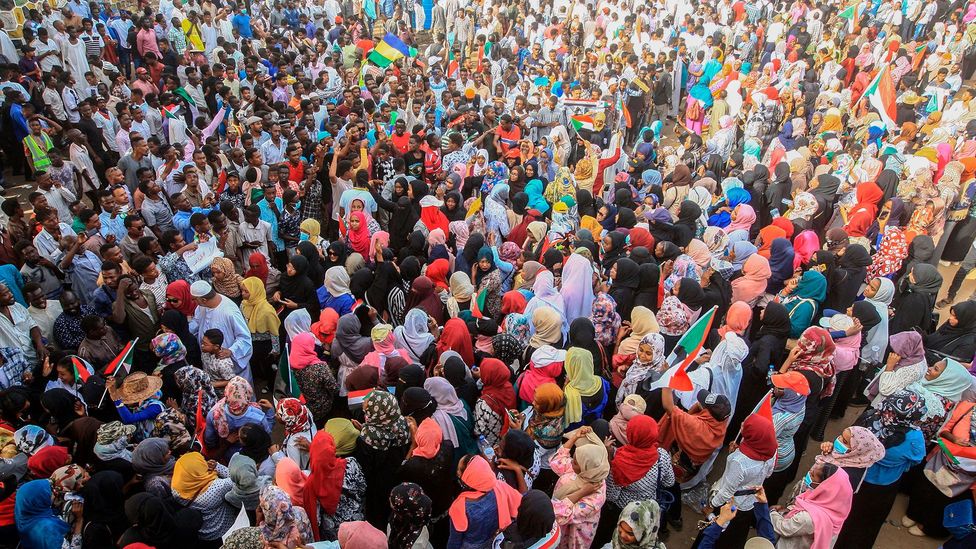
Nonviolent protests are twice as likely to succeed as armed conflicts – and those engaging a threshold of 3.5% of the population take never failed to bring well-nigh change.
I
In 1986, millions of Filipinos took to the streets of Manila in peaceful protest and prayer in the People Power movement. The Marcos regime folded on the quaternary day.
In 2003, the people of Georgia ousted Eduard Shevardnadze through the bloodless Rose Revolution, in which protestors stormed the parliament building holding the flowers in their hands. While in 2019, the presidents of Sudan and Algeria both announced they would step aside after decades in office, thanks to peaceful campaigns of resistance.
You might also enjoy:
• Ten simple ways to human action on climatic change
• The words to get what you desire
• How the views of a few can influence a country
In each case, civil resistance by ordinary members of the public trumped the political aristocracy to attain radical change.
In that location are, of course, many ethical reasons to use nonviolent strategies. Simply compelling inquiry by Erica Chenoweth, a political scientist at Harvard University, confirms that civil defiance is not only the moral choice; it is also the well-nigh powerful style of shaping globe politics – by a long way.
Looking at hundreds of campaigns over the last century, Chenoweth found that nonviolent campaigns are twice as probable to achieve their goals every bit vehement campaigns. And although the verbal dynamics will depend on many factors, she has shown information technology takes around 3.v% of the population actively participating in the protests to ensure serious political alter.
Chenoweth'due south influence tin can be seen in the recent Extinction Rebellion protests, whose founders say they have been direct inspired past her findings. So simply how did she come up to these conclusions?
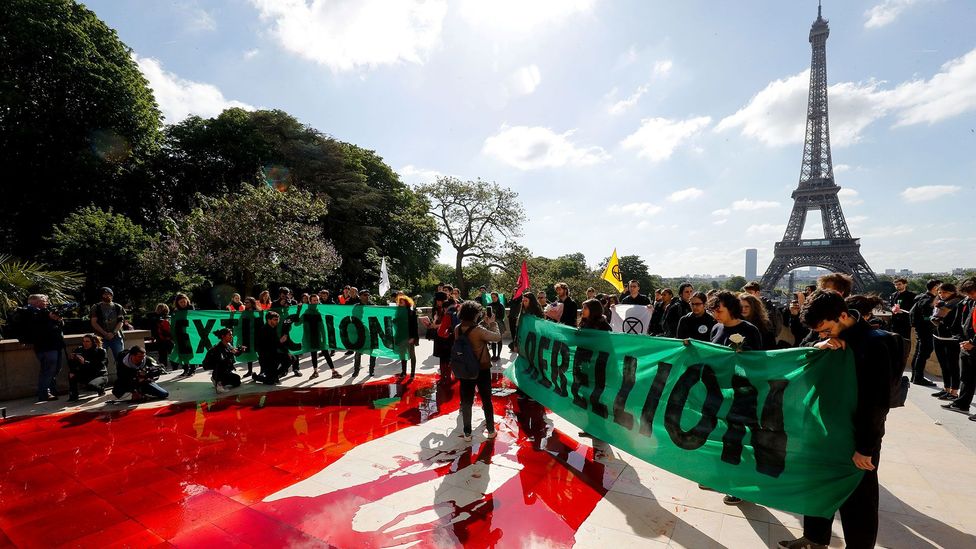
The organisers of Extinction Rebellion take stated that Chenoweth's work inspired their campaign (Credit: Getty Images)
Needless to say, Chenoweth's research builds on the philosophies of many influential figures throughout history. The African-American abolitionist Sojourner Truth, the suffrage campaigner Susan B Anthony, the Indian independence activist Mahatma Gandhi and the Us civil rights campaigner Martin Luther King have all convincingly argued for the power of peaceful protest.
Yet Chenoweth admits that when she first began her research in the mid-2000s, she was initially rather cynical of the thought that nonviolent actions could exist more powerful than armed disharmonize in most situations. As a PhD educatee at the Academy of Colorado, she had spent years studying the factors contributing to the rise of terrorism when she was asked to attend an academic workshop organised past the International Centre of Nonviolent Disharmonize (ICNC), a non-turn a profit organisation based in Washington DC. The workshop presented many compelling examples of peaceful protests bringing about lasting political alter – including, for instance, the People Power protests in the Philippines.
Merely Chenoweth was surprised to detect that no-ane had comprehensively compared the success rates of nonviolent versus tearing protests; perhaps the example studies were but chosen through some kind of confirmation bias. "I was really motivated past some scepticism that irenic resistance could be an effective method for achieving major transformations in society," she says
Working with Maria Stephan, a researcher at the ICNC, Chenoweth performed an extensive review of the literature on civil resistance and social movements from 1900 to 2006 – a information gear up and so corroborated with other experts in the field. They primarily considered attempts to bring about regime modify. A movement was considered a success if it fully achieved its goals both inside a twelvemonth of its peak appointment and as a direct result of its activities. A government change resulting from foreign armed forces intervention would not exist considered a success, for instance. A campaign was considered fierce, meanwhile, if it involved bombings, kidnappings, the destruction of infrastructure – or whatsoever other concrete harm to people or property.
"We were trying to utilise a pretty difficult test to irenic resistance every bit a strategy," Chenoweth says. (The criteria were so strict that India'southward independence motility was non considered as testify in favour of nonviolent protest in Chenoweth and Stephan's analysis – since United kingdom of great britain and northern ireland'south dwindling military resource were considered to accept been a deciding factor, even if the protests themselves were also a huge influence.)
By the end of this process, they had collected data from 323 violent and nonviolent campaigns. And their results – which were published in their book Why Civil Resistance Works: The Strategic Logic of Irenic Conflict – were striking.
Strength in numbers
Overall, irenic campaigns were twice every bit likely to succeed as violent campaigns: they led to political change 53% of the time compared to 26% for the fierce protests.
This was partly the result of strength in numbers. Chenoweth argues that nonviolent campaigns are more likely to succeed considering they tin recruit many more participants from a much broader demographic, which can cause severe disruption that paralyses normal urban life and the functioning of society.
In fact, of the 25 largest campaigns that they studied, 20 were nonviolent, and xiv of these were outright successes. Overall, the irenic campaigns attracted around four times every bit many participants (200,000) as the boilerplate violent entrada (l,000).
The People Power campaign against the Marcos government in the Philippines, for instance, attracted ii meg participants at its tiptop, while the Brazilian insurgence in 1984 and 1985 attracted i million, and the Velvet Revolution in Czechoslovakia in 1989 attracted 500,000 participants.
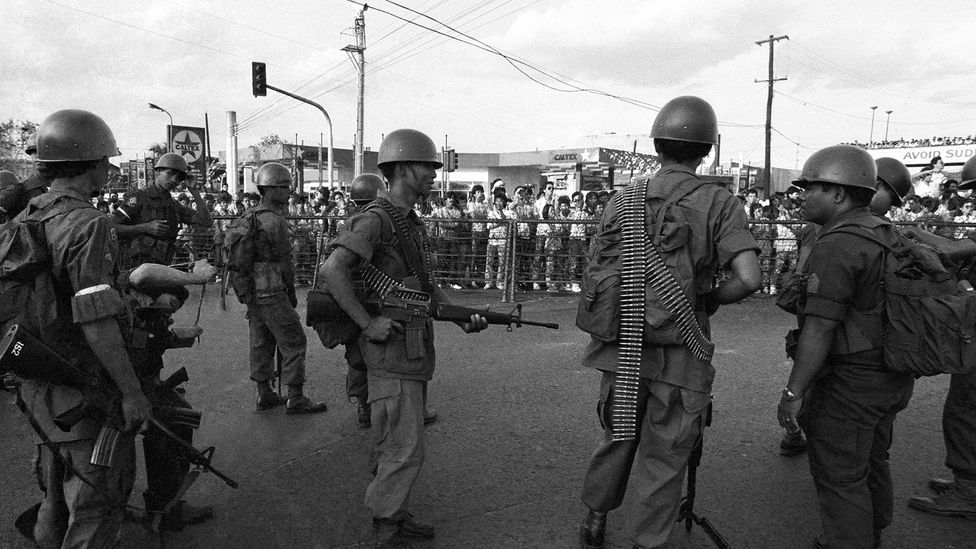
Having attracted millions of supporters, the People Power demonstrations removed the Marcos regime in the Phillipines (Credit: Getty Images)
"Numbers really matter for edifice power in means that can really pose a serious challenge or threat to entrenched government or occupations," Chenoweth says – and nonviolent protest seems to exist the best way to become that widespread support.
In one case around iii.5% of the whole population has begun to participate actively, success appears to be inevitable.
"There weren't whatsoever campaigns that had failed after they had accomplished 3.5% participation during a peak result," says Chenoweth – a phenomenon she has called the "iii.five% rule". Besides the People Power motion, that included the Singing Revolution in Estonia in the belatedly 1980s and the Rose Revolution in Georgia in the early on 2003.
Chenoweth admits that she was initially surprised by her results. But she at present cites many reasons that nonviolent protests can garner such high levels of support. Maybe most manifestly, violent protests necessarily exclude people who abhor and fear bloodshed, whereas peaceful protesters maintain the moral high footing.
Chenoweth points out that irenic protests also have fewer physical barriers to participation. Yous do not need to be fit and healthy to engage in a strike, whereas tearing campaigns tend to lean on the support of physically fit young men. And while many forms of nonviolent protests also carry serious risks – just think of Mainland china's response in Tiananmen Square in 1989 – Chenoweth argues that nonviolent campaigns are generally easier to discuss openly, which ways that news of their occurrence tin reach a wider audition. Fierce movements, on the other mitt, require a supply of weapons, and tend to rely on more secretive underground operations that might struggle to achieve the full general population.
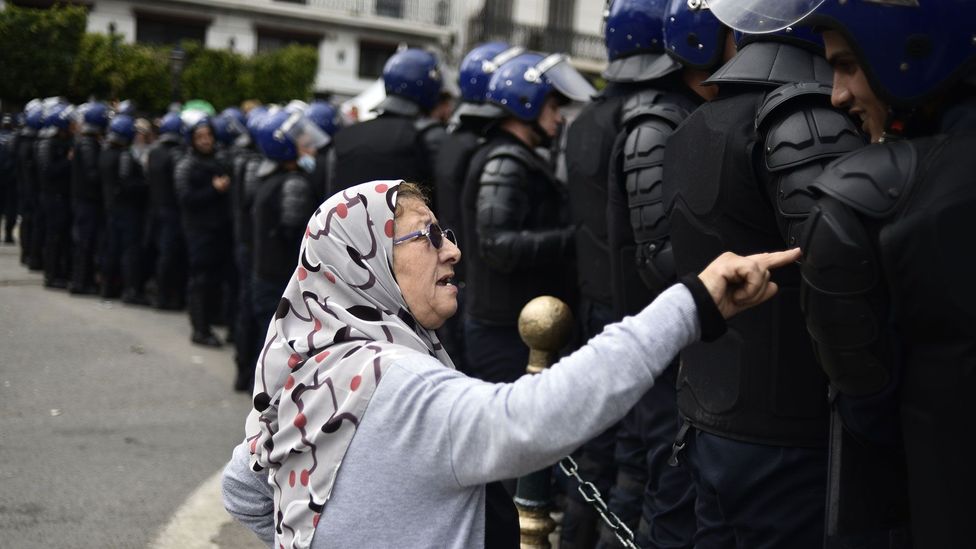
An elderly adult female talks to the Algerian security forces during the recent protests (Credit: Getty Images)
Past engaging broad back up beyond the population, nonviolent campaigns are also more than likely to win support amidst the police force and the military – the very groups that the regime should exist leaning on to bring about order.
During a peaceful street protestation of millions of people, the members of the security forces may also be more likely to fear that their family members or friends are in the crowd – significant that they fail to crack downward on the motion. "Or when they're looking at the [sheer] numbers of people involved, they may just come up to the conclusion the ship has sailed, and they don't want to get down with the ship," Chenoweth says.
In terms of the specific strategies that are used, general strikes "are probably one of the almost powerful, if non the most powerful, single method of nonviolent resistance", Chenoweth says. Only they do come at a personal cost, whereas other forms of protest can be completely anonymous. She points to the consumer boycotts in apartheid-era South Africa, in which many black citizens refused to purchase products from companies with white owners. The result was an economical crisis amid the land'southward white aristocracy that contributed to the terminate of segregation in the early 1990s.
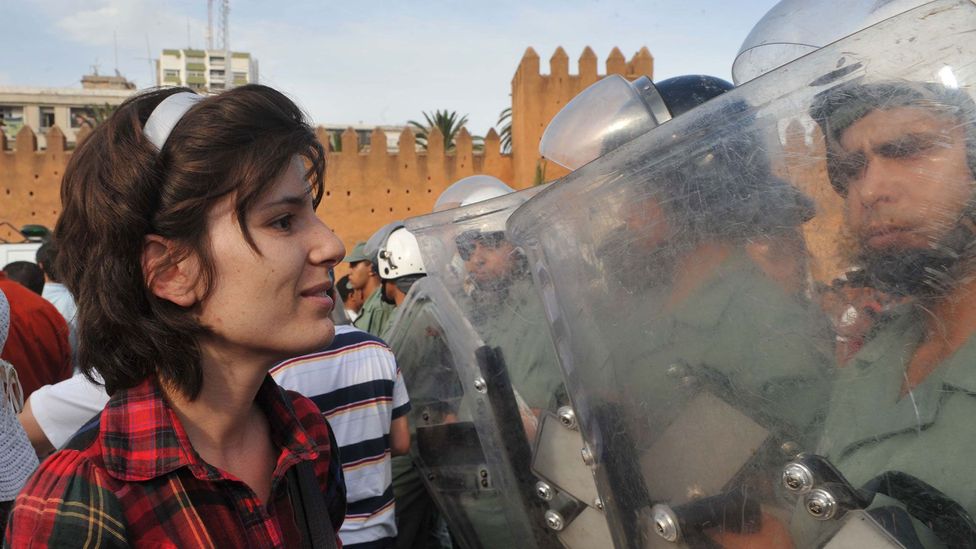
Irenic protests are more likely to concenter support from across society. Here a pro-reform protestor faces security forces in Kingdom of morocco in 2011 (Credit: Getty Images)
"There are more options for engaging and nonviolent resistance that don't place people in as much concrete danger, peculiarly as the numbers grow, compared to armed activeness," Chenoweth says. "And the techniques of irenic resistance are often more than visible, and so that it's easier for people to notice out how to participate direct, and how to coordinate their activities for maximum disruption."
A magic number?
These are very full general patterns, of grade, and despite being twice equally successful as the violent conflicts, peaceful resistance notwithstanding failed 47% of the time. Every bit Chenoweth and Stephan pointed out in their volume, that's sometimes because they never really gained enough support or momentum to "erode the ability base of the adversary and maintain resilience in the face of repression". Simply some relatively large irenic protests likewise failed, such as the protests confronting the communist party in Due east Germany in the 1950s, which attracted 400,000 members (effectually 2% of the population) at their tiptop, merely nevertheless failed to bring nigh alter.
In Chenoweth's information set, information technology was only once the irenic protests had accomplished that 3.5% threshold of active date that success seemed to exist guaranteed – and raising even that level of support is no mean feat. In the UK it would amount to 2.3 million people actively engaging in a move (roughly twice the size of Birmingham, the United kingdom'southward second largest urban center); in the US, information technology would involve 11 million citizens – more the total population of New York City.
The fact remains, nevertheless, that irenic campaigns are the simply reliable way of maintaining that kind of engagement.
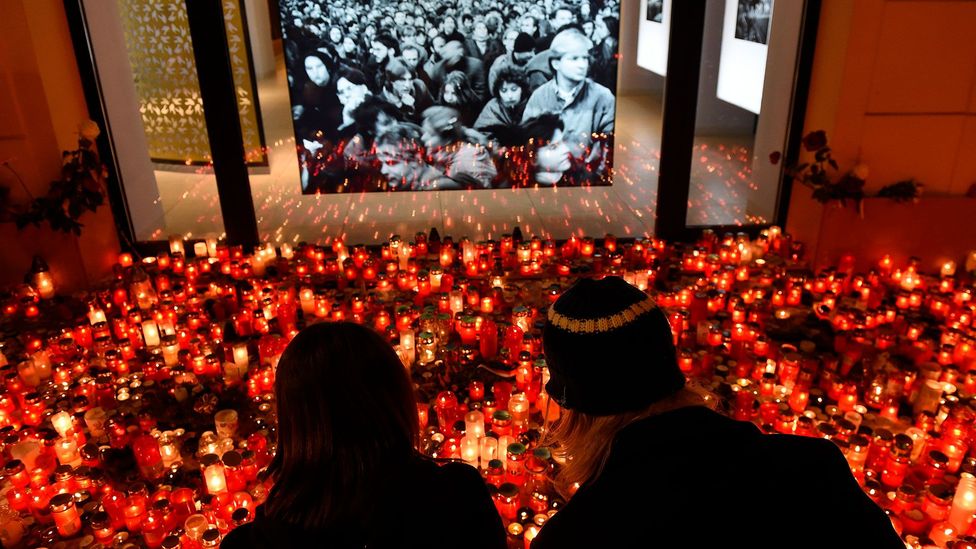
A couple commemorate the Velvet Revolution of 1989, which helped bring down Communist rule in Czechoslovakia - some other example of Chenoweth's "3.five% dominion" (Credit: Getty Images)
Chenoweth and Stephan's initial study was get-go published in 2011 and their findings take attracted a lot of attention since. "Information technology's hard to overstate how influential they accept been to this trunk of research," says Matthew Chandler, who researches civil resistance at the Academy of Notre Matriarch in Indiana.
Isabel Bramsen, who studies international disharmonize at the University of Copenhagen agrees that Chenoweth and Stephan's results are compelling. "It'south [now] an established truth within the field that the nonviolent approaches are much more likely to succeed than violent ones," she says.
Regarding the "3.five% rule", she points out that while three.5% is a pocket-sized minority, such a level of active participation probably means many more than people tacitly concur with the cause.
These researchers are at present looking to further untangle the factors that may lead to a motion's success or failure. Bramsen and Chandler, for example, both emphasise the importance of unity among demonstrators.
Every bit an case, Bramsen points to the failed uprising in Bahrain in 2011. The campaign initially engaged many protestors, but quickly divide into competing factions. The resulting loss of cohesion, Bramsen thinks, ultimately prevented the move from gaining enough momentum to bring about change.
Chenoweth's involvement has recently focused on protests closer to home – similar the Black Lives Matter movement and the Women's March in 2017. She is likewise interested in Extinction Rebellion, recently popularised past the involvement of the Swedish activist Greta Thunberg. "They are up confronting a lot of inertia," she says. "But I call up that they have an incredibly thoughtful and strategic core. And they seem to have all the correct instincts nearly how to develop and teach through a irenic resistance campaigns."
Ultimately, she would like our history books to pay greater attending to nonviolent campaigns rather than concentrating then heavily on warfare. "So many of the histories that we tell one another focus on violence – and even if it is a total disaster, we still find a mode to detect victories within it," she says. Yet we tend to ignore the success of peaceful protest, she says.
"Ordinary people, all the time, are engaging in pretty heroic activities that are actually changing the way the world – and those deserve some observe and celebration likewise."
David Robson is a senior journalist at BBC Future. Follow him on Twitter: @d_a_robson.
--
Join one million Future fans past liking the states on Facebook , or follow us on Twitter or Instagram .
If you liked this story, sign up for the weekly bbc.com features newsletter , chosen "If You Merely Read 6 Things This Week". A handpicked pick of stories from BBC Time to come, Culture, Capital, and Travel, delivered to your inbox every Friday.
Source: https://www.bbc.com/future/article/20190513-it-only-takes-35-of-people-to-change-the-world
Posted by: camachosmon1982.blogspot.com

0 Response to "How To Make Money In The Repopulation"
Post a Comment